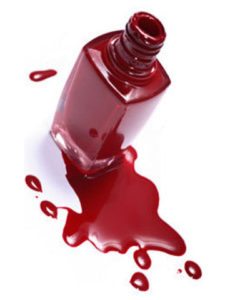
George Blacksell at The Ecologist has the skinny on beauty’s nastiest additives
The beneficial or otherwise nature of the beauty industry’s arsenal of additives has been a hot topic ever since it was first realized that parabens weren’t quite the boon they were thought to be. In the years since concerns about parabens were first raised, other additives turn out to actually have worrying side effects with respiratory problems, rashes and photosensitivity among them.
Skincare rarely contains the sorts of nasties that are part of cleaning products and others. Yet, the scientific jargon and litany of mysterious names has left consumers more confused than ever. Not only are harmless organic compounds such as linalool written off as a possible danger, others such as benzyl – a genuinely nasty additive – slip through the net.
Still unclear? Our A to Z of beauty baddies is here to shed some light.
A for alpha-hydroxy acids (AHA)
Part of a wide range of skin care products, alpha-hydroxy acids, or AHAs, usually come from food products such as sugar cane. Products that contain AHAs cause shedding of the skin, although the extent to which it works depends on the concentration. High concentrations of AHA products are useful in chemical peels and the Food and Drug Association (FDA) warns that that they can increase the skin’s photosensitivity.
B for benzoic acid (benzyl)
Wide use in the fragrance industry. Benzyl is an aromatic alcohol that also serves as a preservative in other cosmetics. Scientific studies cite it as a cause of a wide variety of health problems. Also a respiratory irritant. Subsequent to an evaluation by the Research Institute for Fragrance Materials Expert Panel (REXPAN), the International Fragrance Association set a standard that restricts the use of benzyl in fragrances.
C for chlorobutanol
Common use as a chemical preservative in cosmetic and pharmaceutical products. Usually made up of chloroform and acetone. Continuous use can cause skin or tissue irritation. High exposure to chlorobutanol also carries a small risk of neurotoxic side effects.
D for dibutyl phthalate (DBP)
Once part of nail polishes the world over but evidence of the deleterious health effects of DBP were so convincing that an EU Directive has since banned its usage in the cosmetics industry within the European Union. Despite this, it is still in use by the big name cosmetic brands in the United States, where many nail polish products on the shelves still contain it.
E for ethoxylated surfactants
Useful as foaming agents in soaps, shower gels and shampoos. On the label you will find them by the inclusion of ‘PEG’, ‘-eth’ or ‘-oxynol-‘ in ingredient names. They are prone to oxidation and once oxidised, their products can act as a skin irritant, while frequent exposure can cause eczema.
F for formaldehyde
Formaldehyde is an impurity released by a number of cosmetic preservatives. Considerably health damaging. Formaldehyde was a widely used component of nail polish until recently, when EU health bodies limited the permissible concentration of formaldehyde in cosmetics to 0.2 per cent. Through inhalation of the vapours it releases, formaldehyde can cause breathing difficulties and even trigger asthma attacks in those susceptible to it.
G for glycerin
Common use in the skincare industry for its moisturising and hydrating properties which are in fact false. Glycerin has the opposite effect, drawing moisture from the lower layers of the skin to the top layers where it sits on the surface. In the name of moisturizing outer layers of skin, it literally dried skin out from the inside.
H for hydroquinone
Hydroquinone products are useful for reducing age spots and blemishes, as well as for skin whitening products.The EU market has banned its use due to its high levels of toxicity.
I for isopropyl alcohol
An additive that is mainly part of body creams, aftershave lotions and perfume. Isopropyl Alcohol can compromise your skin’s natural pH level and fatty acids which act as the skin’s primary defense mechanism against viruses, bacteria and fungal infection. High exposure to this ingredient link to central nervous system depression.
J for jargon
Companies often mention the use of collagen and elastin as well as other well-known and impressive sounding additives. The reason for the noticeable increase in medical sounding terminology is its ability to dupe the consumer into thinking they’re buying into proven science when actually, it couldn’t be much further from the truth.
K for kajoic acid
Originates from certain types of mushroom and fermented rice. Marketed as a safer alternative to the hydroquinone as used in skin whitening products. Skin sensitization is one such problem and can in turn lead to dermatitis.
L for lead
Lead is toxic contaminant and exists in a wide variety of lipsticks. The problems include interference with a number of the body’s processes and toxicity to organs and tissues. Concerns about accidental ingestion through licking or biting lipstick-clad lips, although the lead levels are relatively low in most lipsticks.
M for mineral oil
Don’t let the name fool you. This additive has its origins in crude oil and is in fact a metal cutting fluid. It can inhibit the oxygenation process of skin, hindering the release of carbon dioxide and resulting in skin that dries out all too easily. Particularly alarming is its use in a wide range of popular baby oils.
N for nitrosamines
Nitrosamines commonly crop up in cosmetics. Due to the fact that they are impurities, they are not listed on product labels. The UK Department of Business, Enterprise and Regulatory Reform has classified nitrosamines as more toxic in more animal species than any other category of chemical carcinogen. It exists (as an impurity) in a wide range of beauty products, including shampoos, and when washed down the drain, it enters the water cycle causing concern about traces of it in drinking water.
O for organic
Organic beauty products provide a viable, safe alternative to the chemical full conventional sort. Labeling can often be confusing but the best way to be sure if a product is really organic is to see whether it is marked with the Soil Association symbol. That requires a 70 per cent minimum organic content. What’s more, it also ensures that no petro-chemical based or GM ingredients are used.
P for parabens
Parabens have antibacterial and antimicrobial properties. However, they penetrate the skin and mimic the body’s own hormones, disrupting important endocrine functions. The biggest risk comes from long-term exposure, including regular use of skin creams and lotions. Methylparaben has been linked to the premature skin aging. Oh the irony.
Q for quaternium-7
Not only is it toxic and highly allergenic, it also causes the release of formaldehyde. A 2009 report by the Campaign for Safe Cosmetics, No More Toxic Tub, presented third-party laboratory results showing that many baby care products are contaminated with this hyper-toxic ingredient.
R for resorcinol (also dihydroxybenzene)
A carcinogen in a wide variety of products, including shampoo, acne treatments, cleanser and aftershave, resorcinol can have neurotoxic side effects and is particularly damaging for the liver. It’s also an irritant and worse, is extremely poisonous for marine life. One to avoid at all costs.
S for sodium lauryl sulphate (SLS)
Is a chemical that is part of shampoos, hair conditioners, toothpastes and body wash – products you would expect to ‘foam up’. It causes roughness of the skin. By denaturing skin proteins, SLS can have a drying effect. It is a cheap additive that causes that familiar foaming.
T for triclosan
Triclosan is widely used in hygiene products. In Britain alone, the use is between 60 and 90 tonnes per year but its safety credentials have come under scrutiny due to a study by the USA’s Virginia Tech University. It showed that when mixed with chlorinated water, it produces chloroform gas – lethal in high doses and a probable carcinogen. Don’t panic too much though: the amount generated was less than the concentration present in a swimming pool.
U for urea
In farming, urea – a compound in urine – is a fertilizer as an additional source of nitrogen. In beauty, it’s used as an antibacterial preservative and is part of of just about everything. Hair removal creams such as Veet tend to contain higher levels of it. Although the amounts used in cosmetics aren’t high enough to cause problems, concerns exist about urea’s ability to alter the structure of skin; allowing other chemicals through in larger amounts.
V for VP-Methacrylamide
A polymer in mousse and hair gels. It isn’t particularly worrisome in itself, but is often contaminated with toxins, carcinogens and other things you definitely don’t want on your skin. The EU has banned it but USA has not.
W for white petrolatum
A close relative of petroleum jelly, white petrolatum is a derivative of crude oil. While it does have proven protective qualities, its close relationship with non-renewables along with unconfirmed reports linking it to breast cancer make it one ingredient that’s best to avoid.
X for xanthan gum
At its most basic level, xantham gum is a type of fermented glucose with astonishing powers of thickening. That is a trait which is invaluable for beauty product manufacturers. However, in food stuffs it comes under a different chemical formula and with the name, E415. That makes it problematic for anyone with a wheat allergy. It can also cause cramps, bloating and diarrhoea in sufferers.
Y for yohimbine
A naturally occurring substance in Yohimbe and snakeroot, yohimbine is part of diet products and anti-cellulite creams. Often sold as a herbal diet pill, and frequently as an aphrodisiac, it has significant side effects including anxiety, nausea and insomnia. In high doses, it can cause seizures and renal failure.
Z for zinc acetate
A chemical compound commonly part of acne treatments and nappy creams. Zinc acetate is a close relative to zinc oxide (found in sunscreens) but not nearly as harmless. Along with having a negative impact on the immune system, it can also cause asthma attacks and aggravate underlying lung conditions.
***
How do you feel after reading all that about poison in your make-up?
A couple of suggestions:
1. Make it a habit to read the list of ingredients to avoid or minimize poison in your make up
2. Throw away all make up and personal care products that are older than a year
3. Try using brands that minimize the use of nasty chemicals. For example, L’Occitane, Neal’s Yard Remedies, and Forever Living.
Check out our articles on Toxins at Home, Greenwashing and Green Marketing
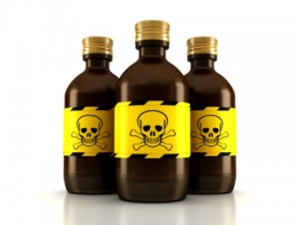
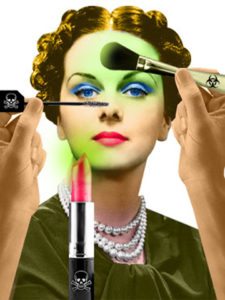
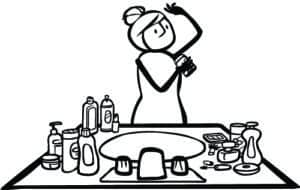
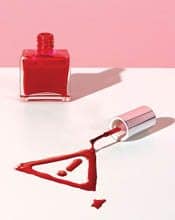









Admittedly this not an area in which I have much expertise. However, I do understand the principle of toxins and hazardous chemicals in everyday products. That so many are so prevalent in makeup ( and other “personal” products) is horrible. Young girls here in America often begin applying makeup on a regular basis before they even enter puberty. I can only imagine the havoc this wreaks on their systems. Greater strides really need to be taken in the promotion of organic options.